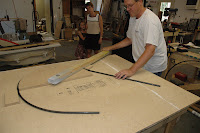



Our bending block has about 180 degrees of arc which is not enough to bend the tube without repositioning. It requires about 255 degrees of bend at the 13" radius to equal the same length of tube when it springs back to the 18+" final shape.

In the photo above you can see that Tom has repositioned the tube to get additional bending. The slider block which is screwed to the 2x4 does not need to be real tight as a little play lets the block have better leverage against the tube while bending.
